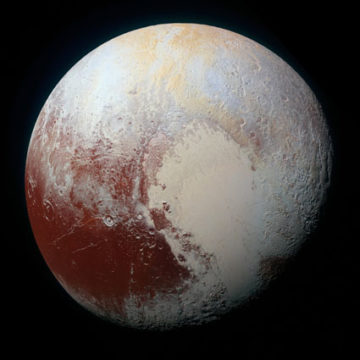New computer simulations suggest that the "beating" of Pluto's frozen heart drives weak winds on this remote world in the outer solar system.

NASA / JHUAPL / SwRI
When NASA’s New Horizon mission flew by Pluto in 2015, the images it returned captured the imagination — especially those of the heart-shaped region named Tombaugh Regio. The left lobe of the heart is called Sputnik Planitia: a 3-km-deep basin filled with nitrogen ice.
Now, Tanguy Bertrand (NASA’s Ames Research Center) and colleagues think that the transformation of nitrogen within that basin determines the pattern of subtle winds over the entire dwarf planet. Their findings were published online on February 4th in the Journal of Geophysical Research: Planets.
Winds on a Remote World
One of the many surprises scientists encountered on Pluto was that this small, remote world in the outer reaches of the solar system has an atmosphere of its own. Granted, it’s thin, mostly nitrogen with a few other trace gases like methane and carbon monoxide thrown in. But there’s enough of it to see in photographs, and it turns out there may even be enough to affect the world’s surface.
Where there’s atmosphere, there’s wind. With such a thin atmosphere, the winds must be weak. Nevertheless, there are hints of it on the surface, such as probable wind streaks west of Sputnik Planitia.
But what drives the winds? Bertrand and his colleagues conducted computer simulations to show that the source is readily visible: the heart of nitrogen ice.
How a Frozen Heart Beats
As Pluto rotates around every six Earth days, most of Sputnik Planitia experiences both day and night. During daytime, weak warmth from the Sun sublimates the nitrogen, heating it from ice directly into gaseous form. Then at night, this nitrogen condenses back into ice. Bertrand’s team nicknamed this cycle Pluto’s heartbeat.
But the heartbeat isn’t regular. Pluto’s spin is tilted with respect to its 248-year orbit around the Sun, so that it’s almost spinning on its side. Right now it’s spring in Pluto’s northern hemisphere, and latitudes above 38°N, including the northern edge of Sputnik Planitia, are in constant daylight. As a result, the nitrogen there is constantly sublimating, increasing the atmospheric pressure that then induces winds toward the southern hemisphere. A mechanism similar to Earth’s Coriolis effect deflects the winds westward, then back southward near the high-relief boundaries of the basin. At the southeastern edge of Sputnik Planitia, which lies close to the part of Pluto under polar night, nitrogen condenses back into ice. Here, the winds turn northerly again, completing the counterclockwise spiral.

T. Bertrand
Paul Schenk (Lunar and Planetary Institute), who was not involved with the current study, agrees that such an atmospheric pattern makes sense. “The fact that the ice sheet is 3 km below the surrounding plains will create an atmospheric imbalance that drives winds,” he adds.
Global Wind Patterns
Although the wind originates in Sputnik Planitia, it doesn’t stop there. Once released into gaseous form, the nitrogen rises to higher altitudes, ultimately entering the airflow controlled by Pluto’s rotation.

T. Bertrand
Just as an ice skater’s spin slows as they stretch their arms away from their body, the nitrogen molecules slow down as they move from north to south, Bertrand explains, because they’re moving farther from the planet’s rotational axis. As a result, the nitrogen gas is moving slower than the dwarf planet below it, causing the winds on Pluto to blow westward — that is, opposite the planet’s rotation.
This retrorotation is unique to Pluto — such overall wind patterns do not exist on any other solar system world, except maybe on Neptune's moon Triton.
“Sputnik Planitia may be as important for Pluto’s climate as the ocean is for Earth’s climate,” Bertrand said. “If you remove Sputnik Planitia – if you remove the heart of Pluto – you won’t have the same circulation.”
Bill McKinnon (Washington University in Saint Louis), who was not involved with the study, agrees, "The nitrogen ice in Sputnik Planitia is certainly the main source and sink of Pluto's atmosphere."
 0
0









Comments
jacobus-nl
February 9, 2020 at 3:22 pm
Hi Julie,
I think a mouse button got overly excited at some point; the section “Just as an ice skater’s spin ...” ended up twice in this article 🙂
It IS exciting of course to learn all these new and detailed insights about ‘minor’ Pluto, when before New Horizons’ visit it was expected to be just a frozen rock!
You must be logged in to post a comment.
You must be logged in to post a comment.